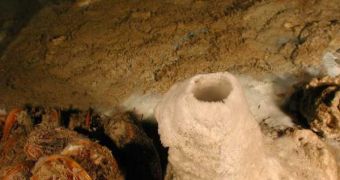A new scientific paper, which appeared in the April 6th issue of the journal Nature Geosciences, sheds some light on the fascinating ecosystems that exist on the floor of the Gulf of Mexico. According to recent investigations, the area around hydrothermal vents is filled with microbial life, which somehow manages to endure in the most extreme conditions, where other species would surely perish. Reddish microbial oozing lives together with a type of dancing eels around mud pots, volcanoes, craters and bubbling gas, in what makes for a highly destructive environment.
“These are the kind of scenes I imagine could exist on distant planets or other astronomical bodies,” University of Georgia (UG) scientist Samantha Joye, who has also been the leader of the latest research in the area, shares. During the studies, deep-sea mud volcanoes, located more than 2,000 feet (600 meters) below the surface, have been analyzed with the help of a submersible craft.
The researcher says that dancing eels were, at times, spotted through the machine's windows, trailing the research team as it moved on the ocean floor, South of the US coastline.
“Here we have more fascinating examples of microbial life coping with very, very unusual environments – regions of the ocean deeps that we can't help but describe as extreme or harsh. Yet, life has clearly adapted to exist, even thrive, in these systems. Such discoveries can't help but lead us to think that life beyond Earth is probable. Also, the discoveries of the evolved strategies for survival in unique environments have the potential to yield new uses of microbial processes and products in the biotech arena,” the Head of the Ocean Section at the National Science Foundation (NSF), Phillip Taylor, adds.
“Near mud volcanoes, we saw thick plumes of gas bubbles ejected from boiling mud pots that are similar to those found in Yellowstone National Park. These gas plumes, consisting mainly of methane, extended hundreds of meters from the sea floor. The diversity and distribution of the microbes we studied say a lot about how life adapts to extreme environments. We believe that the composition of the microbial communities and their metabolisms are linked to environmental differences, mainly in the geochemistry and intensity and frequency of fluid expulsion between the sites,” Joye tells.
The science team is now puzzled at two thing. First of all, how did the microbes get there in the first place? It's very unlikely that they sank to the bottom of the ocean at once, as this would have most likely killed them. The second question is how did they manage to adapt to their environment so quickly, seeing how the briny lakes that exist on the sea floor are only a few thousands of years old, which is very short by geological standards.

 14 DAY TRIAL //
14 DAY TRIAL //